Looking for a few tips and tricks to help keep your tomatoes from splitting and cracking as they grow on your plants?
There is nothing more frustrating than watching your tomatoes suddenly start cracking and spitting apart as they ripen. Splitting causes tomatoes to not only lose their beautiful appearance, but once open, the exposed flesh also becomes highly susceptible to pests, premature rotting, and disease as well.
Even worse, once the damage occurs, the tomato plant has to begin to use valuable resources to try to “heal” the tomato skin – as opposed to using those nutrients for creating more blooms and fruit.
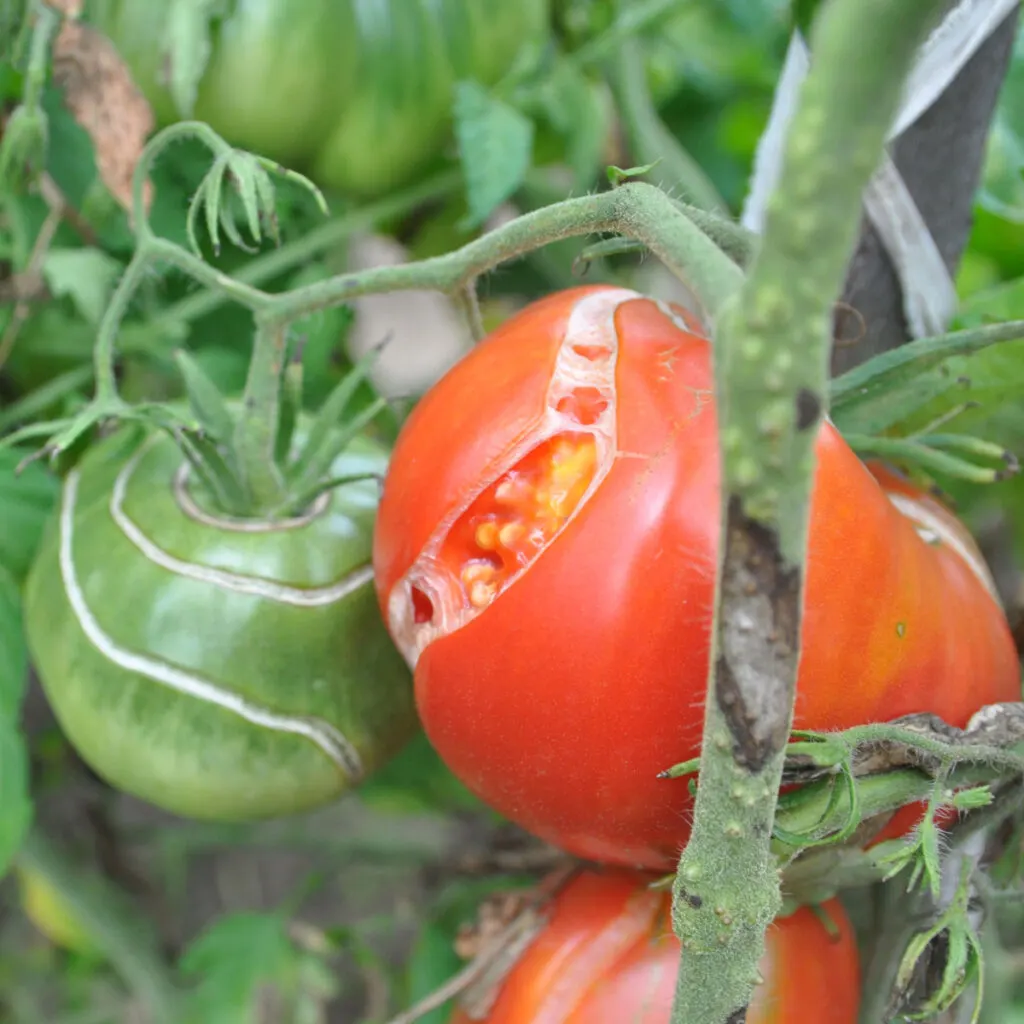
Although watching your ripening tomatoes fall victim to cracking open can be quite disappointing, the good news is that this all-too-common ailment is actually fairly easy to remedy. With that in mind, here’s a look at what is happening when tomatoes split and what you can do to help keep it from happening!
How Tomatoes Split And Crack
There are two main ways that tomatoes can crack and split. The first is at the top of the plant, where cracks or lines form in a circle around the top of the tomato where it attaches to the stem. These marks often look more like scars as opposed to cracks and may not completely expose the flesh below.
This type of cracking occurs more frequently on heirloom or beefsteak tomatoes. That is because the larger fruit of these hefty plants grows so rapidly that the skin is unable to catch up. The result is what appears like stretch marks on the top of the fruit.
The second way tomatoes split or crack is vertically from the top of the fruit to the bottom. These splits are often deeper and expose the juicy flesh below. Unfortunately, all types of tomatoes are susceptible to vertical splitting – even small varieties such as plum and cherry tomatoes.
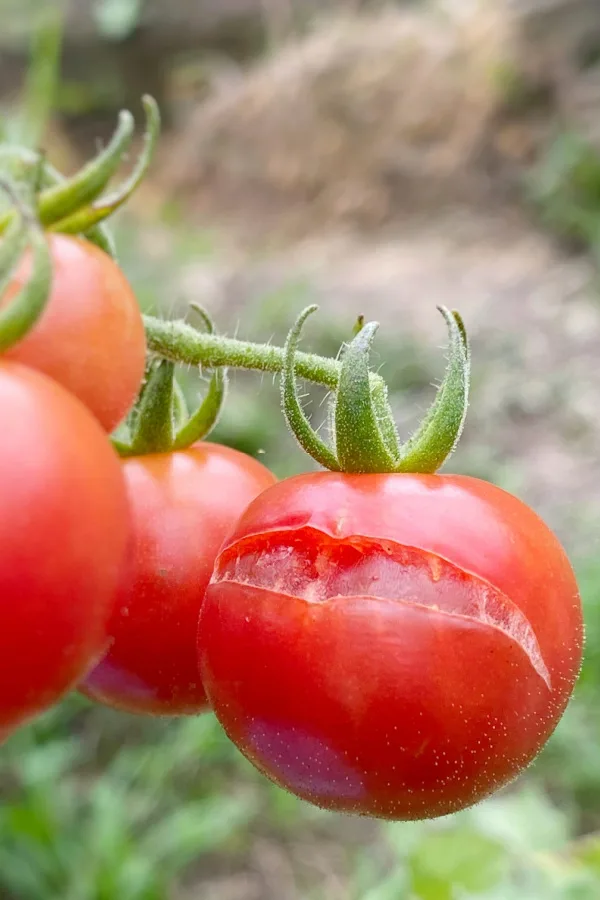
What Causes Splitting & Cracking On A Tomato
You might think that splitting and cracking are caused by a lack of nutrients in the soil. However, that really isn’t the case. Nor is it caused by problems with pests, insects or disease.
The real reason that tomatoes often split and crack is because there has been a rapid change in moisture for the plant. Or more precisely, the plant has experienced a long dry spell followed by a lot of water all at once.
When tomato plants experience infrequent watering and rainfall for a few weeks, they become accustomed to being in dryer soil. But if they suddenly receive a big downpour from a rainstorm, or they are watered heavily all of the sudden, they become highly prone to crack. Why? Because they send all of that water instantly to their fruit and it simply can’t handle it!
When tomato plants stay dry for a long time, they begin to conserve moisture. They hold back from giving the ripening fruit water as a survival instinct. But when they quickly get an abundance of moisture, they to fill out the fruits as fast as possible.
This causes the meaty flesh to grow and expand quicker than the skin can handle. The result is skin that has to crack or split in order to make room for all that new growth.
How To Keep Tomatoes From Splitting And Cracking
Consistent Watering
In order to prevent issues when your plants receive a lot of water all at once, it is important to keep your soil evenly moist at all times.
While you don’t have control over Mother Nature and the amount of rainfall you receive on any given day, you can control the amount of moisture you personally give your tomato plants when you hand water.
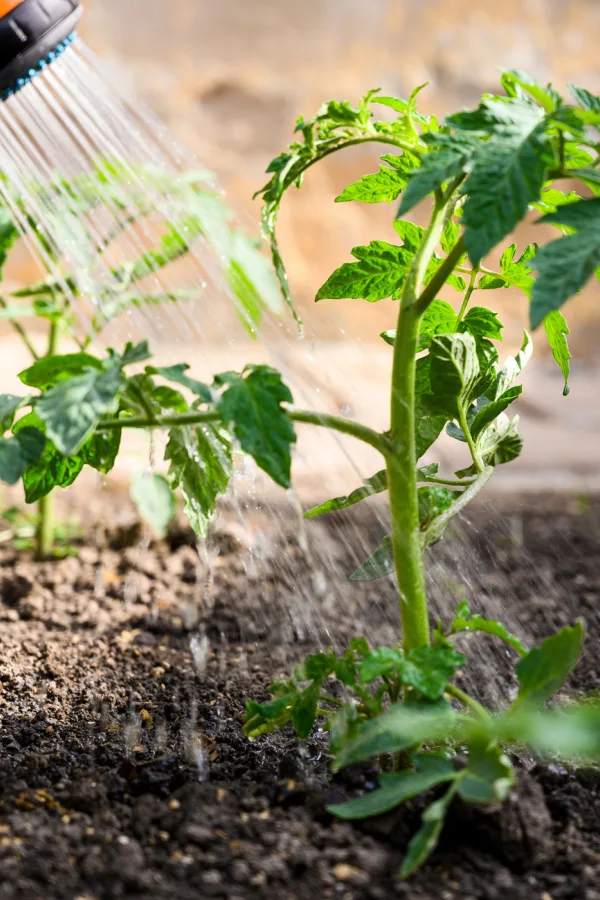
Tomatoes require around 1 to 1.5 inches of water each week. If there are no rain clouds in your weekly forecast, you will need to water plants by hand to make sure they can stay moist.
Instead of giving plants a light watering each day, aim for watering plants deeply once or twice a week. Watering plants deeply will allow the roots to grow down further in the soil. Not only does this help to anchor plants, but it also allows the plants more access to nutrients and other much-needed resources.
Checking Moisture Levels – How To Keep Tomatoes From Splitting And Cracking
So how do you know when plants have received the ideal amount of moisture each week? The best way is to check the soil around each plant.
You can do this by inserting your finger deep into the soil a few inches away from the stem. If it feels damp or you have soil stuck to your finger when you pull it out, you can hold off on watering. If it is dry, it’s time to water.
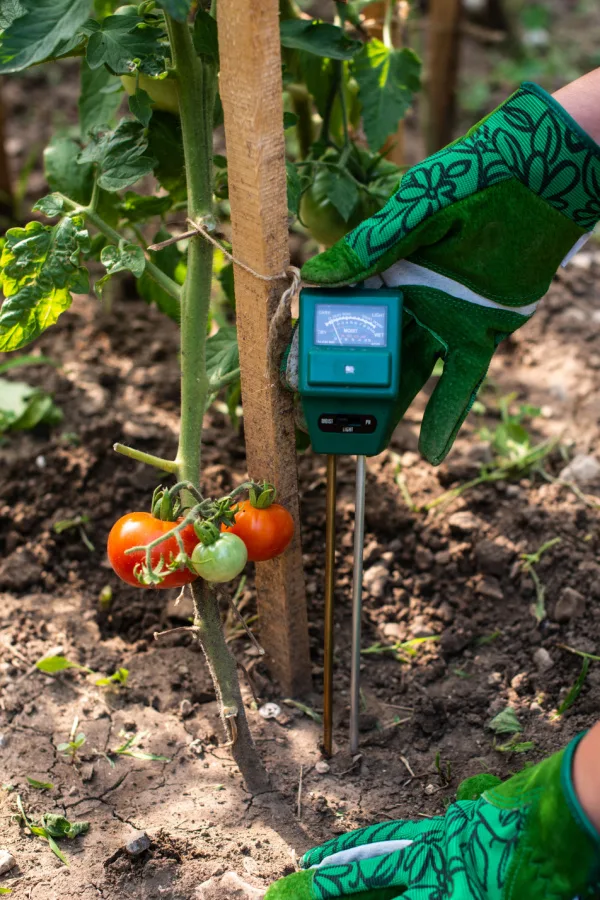
The most accurate and easiest way to check moisture levels at the root level is with an inexpensive soil moisture meter. This simple tool will show you the current amount of moisture deep in the soil. Even better, it does so instantly! See: “How To Use A Moisture Meter – The Perfect Way To Know When To Water.”
Checking your plants regularly is the best way to make sure they are not being over or under-watered. This consistency keeps the soil perfectly moist. That will allow plants to be able to withstand a heavy downpour of rain occasionally – thus better preventing splitting and cracking.
One thing is for sure, if you have had issues with cracking and splitting, a moisture meter really is a great way to make sure your soil has the right amount of moisture at all times. Affiliate Product Link : Soil Moisture Meter
Mulching Plants – How To Keep Tomatoes From Splitting And Cracking
There are so many different advantages of using mulch in your garden spaces. From keeping competing weeds from using up valuable nutrients to reducing soil-borne diseases from splashing onto plants. But mulch can also play a major role in keeping your tomatoes from splitting and cracking!

Mulch helps to regulate the soil temperatures as well as help retain moisture after rainfalls or watering. It also helps to prevent the soil from drying out too quickly, especially in hot climates or drought-like conditions.
Evenly moist soil has less of a chance of plants suddenly soaking up too much water after large rains. When mulching, apply at least a four inch thick layer of straw, grass clippings or shredded leaves around the root zones of your plants.
Harvest Tomatoes Early
Splitting and cracking are typically more of an issue for tomatoes that are almost fully ripe. So it’s in your best interest to harvest your tomatoes early.
As soon as the tomatoes start to turn their final mature color, the ripening process has begun. The tomato no longer needs to be attached to the vine in order to finish ripening. In fact, there are many advantages to picking your tomatoes early and allowing them to ripen OFF the vine.
Besides cracking and splitting, the fruit will have a better chance of being blemish free and not bothered by pests. Just like bright red ripe tomatoes are appealing to you, they are also appealing to hungry insects and other garden pests.
Avoiding Fruit Overload – How To Keep Tomatoes From Splitting And Cracking
Another advantage of allowing tomatoes to ripen off the vine is that the plants can focus their energy on creating new blooms and fruit. When a plant is bogged down with large amounts of fruit (often referred to as “fruit overload”), then it will slow down the production of new blooms.
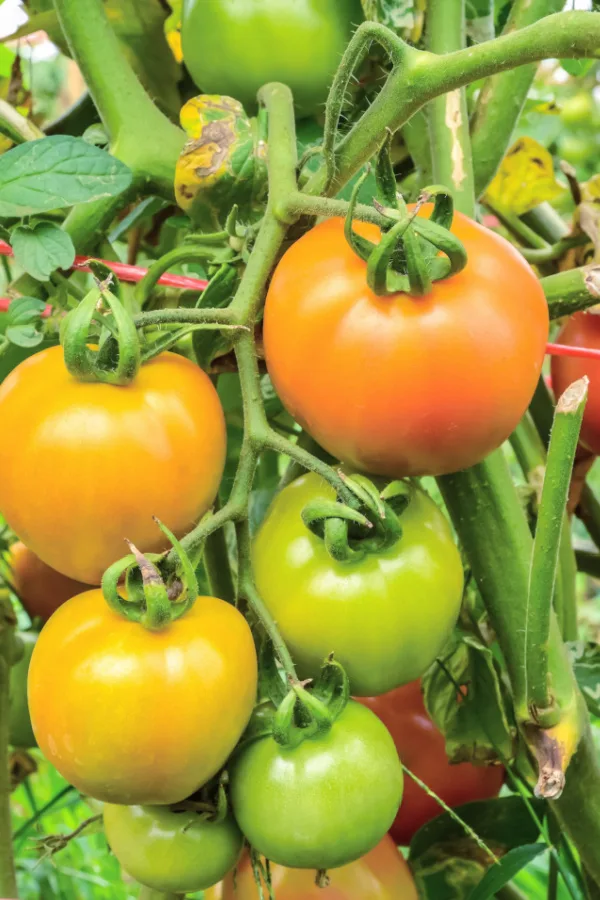
In addition, fruit overload can also cause damage to plants. Strong winds or even heavy rainfalls can cause overloaded stems to bend and snap off. Top-heavy plants can even become uprooted if they are not properly tied down and staked.
So instead of allowing the tomatoes to fully ripen on the plant, pick them as soon as they start to turn color. Allow them to ripen on a wire rack and in a space that has adequate airflow and is out of the sun’s harsh rays. See our: (DIY Harvest Rack Plans)
Here is to keeping your tomatoes from splitting and cracking this year – and to having a beautiful, blemish-free harvest!
Follow Our Facebook Page For Even More Great Tips! Simple Garden Life Facebook Page
Simple Garden Life is a website dedicated to keeping gardening fun, simple and enjoyable! We publish two new articles each week along with a new garden podcast episode every two weeks. This article may contain affiliate links.
